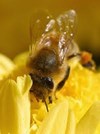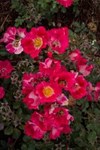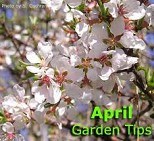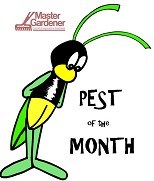Posted 7/13/2012
by Volunteer Master Gardener Barbara Henry

Our gardens are up and growing now and feeding the birds, butterflies and all the various insects that we generally love to see. One of our beneficial insects is the dragonfly; did you know there are 450 species found in North America? Dragonflies begin life as aquatic larvae, feeding on insects, worms, tadpoles, snails and small minnows at the bottom of ponds and streams. When ready for adulthood, the larvae crawl out of the water on to vegetation, the skin splits and the adult emerges. If you have a pond, consider putting a stick or a log in it so the larvae can use it to crawl up from the bottom and out of the pond. Before it can fly the dragonfly must pump its wings full of blood. During these hours, many become food for birds, frogs, spiders and even other dragonflies.
Once airborne, the dragonfly is an expert flyer. While its wing design is quite primitive, it is extremely efficient using very little energy per unit of distance traveled.
They have very sharp vision due to their huge compound eyes. Eighty percent of their brain is devoted to processing visual information which is a great asset for hunting prey and avoiding predators.
The adult has a voracious appetite for pest insects such as mosquitoes, black flies, horse flies, aphids and grasshoppers. And many creatures feed on their larvae – amphibians, fish and birds for example.
Thanks to the Horticultural News, Nassau County Extension for this information.
Posted 7/10/2012

When you garden ecologically, the goal is to keep insect pests below population levels where they will cause unacceptable damage, rather than try to get rid of all of them. Preserving natural enemies may be the most important and readily available biological control practice you can undertake in your battle of the insects. As you rely on natural enemies to help you, you need to foster them by providing their needs. One method consists of increasing the diversity of plants in or near the garden to attract more beneficial insects to the area.
Natural enemies, or “good bugs”, can provide a safe, environmentally friendly means of suppressing pests. Most insects that live in or near our gardens are not harmful; most are in fact are beneficial! Insects’ natural enemies can be predators or parasitoids.
Predators such as lady beetles and lacewings are mainly free living species that consume many prey during their lifetime. Another important group of predators are the spiders; scientists are just beginning to recognize the importance of spiders as natural enemies and in some countries they are being brought in to help control insect pests.
Parasitoids, which include many wasps and flies, are more specialized than predators; the immature stage actually develops within the body of a single insect, ultimately killing it. The adults are free living and often visit flowers for nectar and pollen.
Select plants for your garden that are known to lure insects’ natural enemies to help you attract and conserve these garden helpers. Two large groups, or families of plants, are excellent “lures” – the parsley family (Umbelliferae) and the sunflower or daisy family (Compositae).
You can spot members of the Umbelliferae family by their umbrella-shaped clusters of small 5-petaled flowers. The overall
appearance is often a large flat head of white or yellow flowers; Queen Anne’s lace is a good example. The flower head provides a place to land for many insects, especially beneficial wasps. Using a variety of these plants that bloom at different times can make your garden look attractive, too. A number of culinary herbs in this plant family including parsley, dill, caraway, cilantro or coriander, and fennel. Some of these herbs are very attractive to syrphid and tachinid flies, assassin bugs, lacewings and parasitic wasps. One caution – these plants will spread quickly if left to go to seed, so remove flower heads after they stop producing nectar, but before seeds mature. Also, some are biennials, so you won’t see flowers appear for a year.
The Compositae family is characterized by flower heads that are actually made up of many small flowers growing together. Many flowers are composed of rays around a disk-like center. Many well-known ornamental flowers including marigolds, dahlias, daisies, asters, cosmos, calendula, coreopsis, tansy, yarrow, zinnia, and sunflowers are in this family. Flowering often lasts over a long period of time and there is usually more than one flower per plant. This provides a slow flow of nectar over a long period for the insects. Ladybugs, lacewings, parasitic wasps and some predaceous wasps are attracted to plants in this family. Soldier beetles, flower beetles, and some lady beetles will feed on pollen in addition to feeding on insects. Dandelions offer early spring pollen to some of these insect predators.
Legumes such as clovers and vetch also attract beneficials. They add nitrogen to the soil, provide good shelter and moisture for insects, and may even serve as a source of alternative prey for natural enemies. Beneficial insects such as ground beetles, rove beetles and robber fly larvae are often found in the soil.
Cover crops offer protection to natural enemies when our annual garden plants are not actively growing. Often, beneficial insects move over from the cover crops as these crops begin to die back, feeding on “bad” insects that are in turn consuming the desirable garden plants. Buckwheat is a good one because it not only provides shelter, but has flowers which attract flies, ladybugs and pollinating bees. One caution, however, is that it does self-seed readily! A small permanent planting of buckwheat near the garden allows immature natural enemies to complete development without seeding up your garden.
If attracting – and keeping – the “good guys” to your garden is what you would like to do, try planting a few of the “lure” plants from the parsley and sunflower families this year!
Posted 7/5/2012
Do your flowering plants have leaves and flowers with holes chewed in them? Do you have entire plants that have been chewed down to the ground? It takes a little investigative work to find out what exactly is eating the garden. The first thing to do is to look carefully at the damage and at any signs left behind.
Damage may be caused by an animal such as a rabbit or woodchuck if, in a short period of time:
- Large parts of the plant are chewed off
- New growth is uniformly nibbled off
- Plants are eaten to the ground.
It is no secret that rabbits love petunia flowers and will nibble away at flowers and new growth. Woodchucks tend to leave trampled plants in the process and feed during the daylight close to their burrows. To determine if an animal is causing the damage, sprinkle a layer of fine ground limestone around the plants and look for animal tracks left in the powder the next day.
If the damage has been occurring slowly with a little feeding each night, caterpillars, slugs or beetles may be the culprits. To distinguish between these three look for signs left behind. Caterpillars leave fecal droppings under the leaves or around the damage. Droppings look like small pellets.
Posted 6/26/2012
by Volunteer Master Gardener Phyllis Minich

The #1 Question: “How often should I water?”
The REAL answer: “When your plant needs it!”
THE Goal: For your plants to be as self sufficient as possible!
The Basic Guidelines:
• Amend your soil with compost & mulch.
• Build watering basins around new plants.
• Hand water for at least the first week or two.
• Water deeply & thoroughly when you water.
• Allow as much time between waterings as possible.
• Pay close attention to your plants for the first 3 months (especially new trees).
• Adjust your watering as conditions change & as plants mature.
• Enjoy your garden regularly, look at your plants & listen to their needs.
Most Common Pitfalls:
• Poorly amended soil
• Planting too deep
• Shallow watering (= shallow roots)
• Watering too frequently
• Forgotten irrigation systems (clogs, adjusting for weather, etc.)
Posted 6/25/2012
by Volunteer Master Gardener Barbara Henry

The Asian Long Horn beetle has been deemed an invasive species in North America. It infests many hardwood trees – maples, horse chestnuts, poplars, willows, birches to name just a few. It is a large black insect, with white spots dashed irregularly on its body which is about one and a half inches long. The distinctive long antennae that give the beetle its common name are as long as the body in females and almost twice the body length in males and are also splashed with white. Like the ash borer, the larvae tunnel into the tree and disrupt the water and nutrients flow, eventually killing it. During the summer months the females can chew up to 90 holes into a tree’s bark and they lay an egg in each of the holes. The eggs hatch in 10-15 days and start chewing. They dig deeper into the tree as they grow and eventually pupate and live inside the tree over winter emerging from spring through as late as October. Watch for perfectly round exit holes a little less than an half inch round. Usually they will lay eggs in the same tree but when the population gets too high they will migrate in the spring to some other unlucky tree.
Unfortunately no good controls exist for this beetle though research has shown some promise. If you see either of the beetles, do kill them. I’m not usually in favor of killing anything but wasn’t it Mr. Spock who said that the needs of the many outweigh the needs of the few? So in this case, the survival of our forests and hardwoods definitely outweigh the life of this critter. Also remember that it is illegal to bring untreated firewood into New York State. Many pests have hidden in and been transported by firewood from neighboring states.
Posted 6/21/2012

Support our local pollinators. Build a bee house. Take a block of untreated wood and drill holes (5/16th of an inch works best for Mason bees) three to five inches deep but not all the way though the wood block. For example, get a four inch by four inch piece of wood and drill holes that are three and a half inches deep. You can top it with a piece of siding to keep the holes dry and you can put chicken wire over the front to protect the holes from the birds. Secure to a pole facing south in your garden. The bees will lay their eggs in the holes and then plug it up.
Posted 6/20/2012

These can be a wonderful addition to our gardens. Hardy to our area and mostly deer resistant, they don’t take a lot of maintenance and the rose hips feed the birds and the shrub form provides cover for birds and small mammals.
All roses are susceptible to blackspot. This comes from spores that live in the soil and they splash up onto the leaves and canes when it rains or when you do some overhead watering. If you have just a few leaves that are affected, just cut them off and burn them. It’s usually not recommended to put them in your compost pile because the pile simply doesn’t heat up enough to kill the spores. If you have badly infected plants drench the plants early in the season with a general purpose fungicide and then continue throughout the season according to label directions. For mild infections you can spray your plants with a mixture of one teaspoon of baking soda and half a teaspoon of dish soap with one quart of water. Shake it up well and spray on cloudy mornings – to prevent any chance of leaf burn and to let the plants dry well during the day. Do this once a week and make sure to get the underside of the leaves. In the fall, be sure to clean up any leaves to minimize the spores hiding out over winter.
Japanese beetles will come to your plant but if there are only a few, you can hand pick them. Mid August through mid September is a very good time to put down grub control to kill off the adults for next year. The beetles are good flyers and even if you put down grub control in your yard they can fly in from 10 miles away to enjoy your garden buffet. We have fact sheets with more information on how to control these pests, call our office for a copy – 762-3909, extension 107.
Posted 6/14/2012

Ladybugs are important predators of aphids and other insects. Many organizations sell ladybugs as a natural insect control. However, if you buy these insects to put out in your yard or garden, they must be handled properly so that you receive the full benefit from them.
Ladybugs, or more properly lady beetles, are roundish insects that are usually less than 1/4-inch long. Most of us are familiar with the convergent lady beetle—colored orangish-red with several black spots. Lady beetles may also be brown, yellow, red, pink, orange, or tan with or without black spots, or they may be black with or without red spots.
Lady beetle larvae hatch from yellowish-orange eggs laid in a cluster. The larvae are usually elongated, black and orange, and have large jaws.
Since lady beetles are already present in most areas, you can increase the effectiveness of lady beetles in your own yard if the insects have mulched areas in which to overwinter and insecticides are used sparingly. These practices will probably result in more lady beetles in your yard than if you purchased them....
Posted 6/12/2012
by Master Gardener Phyllis Minich

What is Integrated Pest Management (IPM)?
The New York State Integrated Pest Management Program develops sustainable ways to manage pests and helps people to use methods that minimize environmental, health, and economic risks.
Download a fact sheet about the six principles of IPM.
Posted 6/7/2012

The Emerald Ash Borer was found inn 2009 in an infestation found in Cattaraugus County. The adult beetle is a metallic green, around a half inch long. The adults are active May through August and the ash trees upon which they feed decline quickly and can be dead within a few months as the larvae bore into the tree and cut off its supply of water and nutrients. The DEC has set up traps to check population and they have put some in both Fulton and Montgomery counties. If you see any of the beetles, you are asked to call the DEC and let them know where and when.
Unfortunately no good controls exist for this beetle, though research has shown some promise. If you see them, destroy them - the survival of our forests and hardwoods definitely outweigh the life of this critter. Also remember that it is illegal to bring untreated firewood into New York State. Many pests have hidden in and have been transported by firewood.













